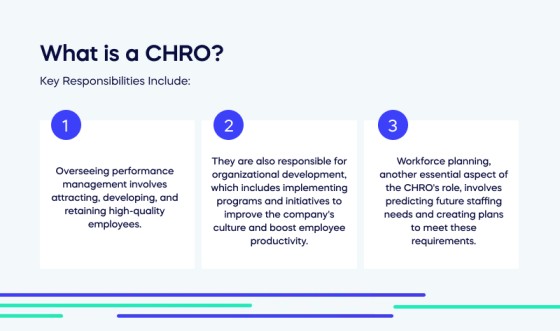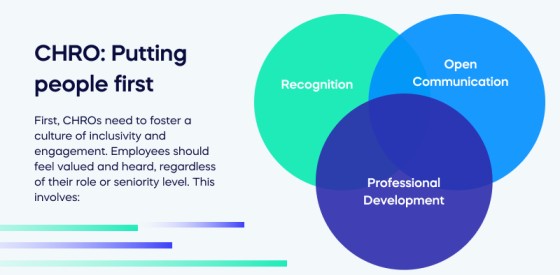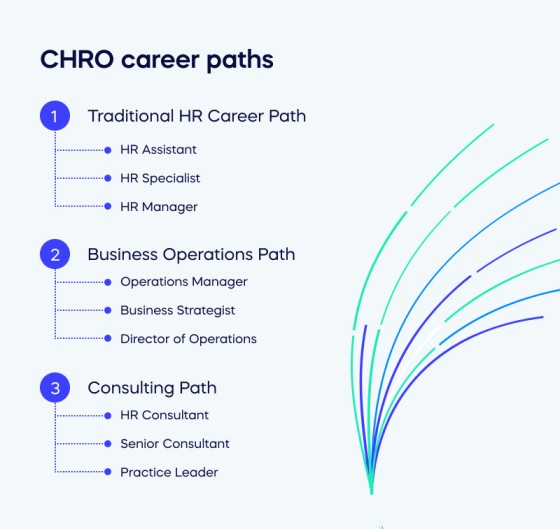In the dynamic world of human resources (HR), the role of a Chief Human Resources Officer (CHRO) is pivotal.
A people-first culture puts employees at the heart of business strategy, recognizing their value as the company’s most significant asset. It shifts the focus from mere productivity to holistic change and development, encompassing professional growth, personal well-being, and job satisfaction.
This approach is instrumental in attracting and retaining top talent, enhancing employee engagement, and ultimately driving business success.
This article examines how a CHRO can foster a people-first culture within an organization. It’s not just about implementing policies or managing your HR strategy; it’s about cultivating an environment that prioritizes employee welfare and satisfaction.
As we delve deeper, we will explore the strategic initiatives a CHRO can undertake to build such a culture, the challenges they may face, and the measurable impact of these efforts on organizational performance. This exploration provides insights for HR leaders striving to create a more inclusive, engaging, and productive workplace.
What is a CHRO?

A Chief Human Resources Officer (CHRO) is an executive-level role in an organization responsible for developing and executing human resource strategy, including talent management, organizational development, workforce planning, performance management, diversity, compliance, compensation, and benefits.
The Chief Human Resources Officer (CHRO) is a crucial member of an organization’s executive team. They hold strategic responsibility for the people dimension of the organization, ensuring that human resources policies and practices align with the company’s overall business plan.
Key Responsibilities Include:
- Overseeing performance management involves attracting, developing, and retaining high-quality employees.
- They are also responsible for organizational development, which includes implementing programs and initiatives to improve the company’s culture and boost employee productivity.
- Workforce planning, another essential aspect of the CHRO’s role, involves predicting future staffing needs and creating plans to meet these requirements. This can include succession planning and career development programs.
The Strategic Role of a CHRO
The Chief Human Resources Officer (CHRO) plays a pivotal role in the success of a modern organization.
As businesses navigate through a rapidly changing landscape, driven by factors such as digital transformation and shifting employee expectations, the CHRO becomes a strategic partner in driving organizational effectiveness.
Talent Management: One key area the CHRO significantly impacts is talent management. By anticipating future skills needs, the CHRO ensures that the organization stays competitive. They are responsible for developing robust recruitment strategies, managing talent development programs, and overseeing succession planning.
By doing so, they help to build a workforce that is capable, motivated, and aligned with the organization’s strategic goals.
Shaping Organizational Culture: The CHRO plays a crucial role in shaping the organization’s culture. They can create an environment that fosters collaboration, innovation, and inclusivity.
By implementing policies that promote diversity, equity, and inclusion, the CHRO can help to attract a wider range of talent and foster a culture of respect and belonging.
Driving Employee Engagement and Productivity: The CHRO is instrumental in driving employee engagement and productivity. They implement programs to boost morale, manage performance, and ensure employee well-being.
These initiatives contribute to a positive working environment and directly impact the bottom line.
Risk Management: The CHRO is an essential player in risk management. They oversee compliance with labor laws and regulations and manage potential risks related to human resources.
This includes everything from mitigating the risk of employee litigation to managing the fallout from reputational damage.
CHRO: Putting people first

As the Chief Human Resources Officer (CHRO), putting people first is not just a slogan but a strategic imperative that drives every decision. In an increasingly competitive business landscape, organizations that prioritize their people tend to outperform those that don’t.
Let’s delve deeper into how CHROs can put people first.
First, CHROs need to foster a culture of inclusivity and engagement. Employees should feel valued and heard, regardless of their role or seniority level. This involves:
- Open Communication: Establish clear and consistent communication lines at all levels to ensure everyone feels informed and involved.
- Recognition: Regularly acknowledging and rewarding employees’ efforts and accomplishments to boost morale and motivation.
- Professional Development: Providing opportunities for learning and growth to help employees advance in their careers.
CHROs need to focus on talent development and succession planning. Companies can ensure continuity and stability by identifying high-potential employees and grooming them for leadership roles. This includes:
- Mentorship Programs: Pairing junior staff members with experienced leaders who can provide guidance and support.
- Leadership Training: Offering formal training programs to develop the necessary skills for future leadership roles.
- Career Pathing: Outlining clear career paths that show employees how they can progress within the organization.
CHROs must prioritize employee well-being. This means ensuring a safe and healthy work environment and providing resources to support employees’ mental health. Actions in this regard may involve:
- Work-Life Balance: Promoting flexible working hours and remote work options to help employees balance their professional and personal lives.
- Health and Wellness Programs: Implement initiatives encouraging healthy habits, such as exercise programs, mental health resources, and nutritional advice.
- Employee Assistance Programs: Providing support services for employees dealing with personal issues, such as stress, anxiety, or financial difficulties.
CHROs must leverage technology to streamline HR processes and enhance the employee experience. Technology can play a crucial role in recruitment and onboarding, performance management, and employee engagement. Key technology considerations include:
- HRIS Systems: Implementing Human Resources Information Systems (HRIS) to efficiently manage employee data and HR processes.
- Analytics: Using data analytics to gain insights into employee behavior, satisfaction, and performance.
- Digital Learning Platforms: Utilizing digital platforms to deliver training and development programs.
Now we’ve explored how CHROs can put people first and the strategic initiatives they can undertake. Let’s discuss the measurable impact of these efforts.
Impact of CHRO Initiatives
The CHRO’s strategic leadership can significantly influence business outcomes by shaping company culture, improving employee engagement, and driving innovation.
Listed below are four case studies illustrating the transformative impact of CHROs on businesses across various sectors:
Case Study 1: Morneau Shepell – Harnessing Human Capital
Morneau Shepell, a leading provider of technology-enabled HR services, exemplifies how effective human capital management can enhance business performance.
A white paper published by the company outlines how its human resources strategies have positively influenced employee contributions and overall business results. The CHRO’s role was instrumental in developing these strategies, which focused on employee wellness, engagement, and productivity.
By crafting policies that address employees’ holistic needs, Morneau Shepell’s CHRO has played a pivotal role in driving the company’s success.
Case Study 2: The Healthcare Industry – Telemonitoring and Employee Wellness
While not a traditional business environment, the healthcare sector offers valuable insights into how CHROs can leverage technology for improved outcomes.
A study from the Journal of the American Medical Informatics Association highlights how telemonitoring positively affects patient care. Extrapolating this to a business context, CHROs can implement similar technologies to monitor and improve employee wellness.
Such initiatives can lead to increased employee satisfaction, reduced absenteeism, and, consequently, improved business performance.
Case Study 3: Urban Education – Strategic Community Partnerships
A case study in the Urban Education Journal provides an example of how strategic partnerships can yield long-term benefits.
The study applied Bronfenbrenner’s ecological theory to understand community partnerships in an urban high school. While this is an educational context, the lessons learned are applicable to business environments.
A CHRO can forge strategic partnerships to enhance various aspects of the business, from talent acquisition to corporate social responsibility. In doing so, the CHRO can drive positive change within the organization and the wider community.
CHRO career paths

If you’re looking to pursue a career as a CHRO or gain insights into the profession, you’ll find plenty of resources available online. Some of the most notable career paths include:
Traditional HR Career Path
The most common CHRO (Chief Human Resources Officer) career path begins with a foundational role in human resources. Individuals often start as:
- HR Assistant: Entry-level role responsible for administrative tasks like maintaining employee records.
- HR Specialist: A mid-level position where individuals specialize in a specific HR, such as recruitment or employee relations.
- HR Manager: Overseeing the implementation of HR policies and managing HR staff.
Business Operations Path
Another popular CHRO career path involves transitioning from business operations to human resources. This path often includes roles such as:
- Operations Manager: Responsible for overseeing daily operations and ensuring efficiency.
- Business Strategist: Develops and implements strategic plans to meet business objectives.
- Director of Operations: Oversee multiple departmental functions and ensure organizational synergy.
Consulting Path
Consulting is another viable CHRO career path. Professionals generally progress through roles like:
- HR Consultant: Provides external advice to organizations on HR practices.
- Senior Consultant: Leads consulting projects and develops HR solutions.
- Practice Leader: Oversees a team of consultants and drives business development in the HR consulting space.
Regardless of the path chosen, aspiring CHROs must demonstrate strong leadership skills, strategic thinking, and a deep understanding of how people and processes drive business success.
Gaining experience in various HR disciplines and obtaining relevant certifications can greatly enhance career progression.
What’s next for the CHRO?
The evolving landscape of the 21st century necessitates a paradigm shift in the Chief Human Resources Officer (CHRO) role. This transformation is largely driven by technological advancements, particularly data analytics, artificial intelligence (AI), and cloud-based solutions.
In the future, CHROs must incorporate HR analytics into their strategic decision-making processes. The ability to analyze employee performance metrics, retention rates, and talent acquisition strategies will take precedence over traditional intuition-based methods. This shift towards data-driven cultures reflects the increasing importance of quantitative insights in shaping an organization’s human resources strategy.
Simultaneously, CHROs will become pivotal agents in digital transformation initiatives within their organizations. The responsibility of ensuring that HR systems and processes are digitally current and efficient will fall under their purview. This includes implementing AI-driven tools for tasks such as resume screening, onboarding procedures, and employee engagement surveys.
Furthermore, the role of the CHRO will expand to include a more strategic partnership with the CEO. This involves aligning HR objectives with overarching business goals, positioning the CHRO as a critical contributor to overall business strategy. The human element remains central to any organization, and the CHRO’s strategic role in managing this resource cannot be understated.
Finally, the rise of remote work necessitates a new approach to workforce management. CHROs will be tasked with maintaining culture and engagement within geographically dispersed teams, underscoring the need for innovative virtual management strategies.
In essence, the technical evolution of the CHRO role signifies a transition from a traditional HR manager to a strategic business leader.
The future CHRO must be a tech-savvy, data-driven decision-maker who balances technological integration with the fundamental human element inherent in their role.


